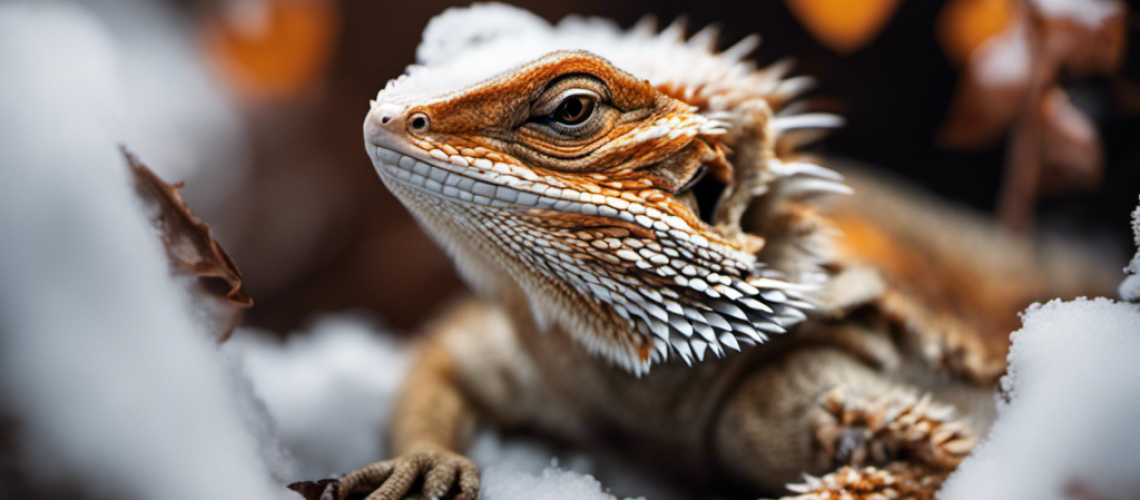Have you noticed your bearded dragon slowing down, sleeping more, or refusing to eat? They may be brumating! Brumation is the reptilian equivalent of hibernation and is a natural part of a bearded dragon’s life cycle.
Knowing the signs and stages of brumation can help you prepare for winter slumber and ensure your pet is comfortable during this process.
Read on to learn how to recognize signs of bearded dragon brumation.
Key Takeaways
- Brumation is the reptilian equivalent of hibernation and a natural part of a bearded dragon’s life cycle.
- Changes in appetite, activity level, and sleeping habits may indicate brumation, which is commonly triggered by shorter days and colder weather.
- It is important to create a warm and comfortable environment for the dragon and provide adequate food and water before brumation begins.
- Monitoring the dragon closely for changes in behavior and appetite during brumation, as well as providing appropriate care before and after, is crucial for a healthy transition back into activity.
What Is Brumation
You may have heard of brumation, which is a type of hibernation that bearded dragons go through. With longer days and cooler temperatures, their diet changes too.
During this period, they become less active and sleep more often; it’s important to recognize these signs so you can help your dragon prepare for winter slumber. Make sure to provide them with adequate nutrition and warmth during this time as well as plenty of light exposure.
Brumation can last between one and three months, so be mindful of the changing seasons when caring for your beloved pet!
Signs of Bearded Dragon Brumation
If y’all notice changes in appetite, activity level, and sleeping habits, it could be a sign that your bearded dragon is brumating.
Common triggers include shorter days and colder weather.
It’s important to remember the myths about brumation don’t apply- it doesn’t mean your dragon is sick or dead!
Keep an eye out for other signs like erratic behavior to make sure they’re staying healthy during their winter slumber.
Preparing for Brumation
To ensure your pet stays healthy during its hibernation period, it’s important to prepare for brumation in advance.
Create a warm and comfortable environment by seeking out areas of warmth such as under the basking light or near heat sources.
Ensure food and water is provided before the dragon begins to brumate.
Check that the humidity levels are stable and provide enrichment activities for mental stimulation.
Talk to an experienced reptile vet if you have any questions about preparing for brumation.
With proper preparation, your bearded dragon can enjoy a safe winter slumber!
During Brumation
During brumation, it’s important to monitor your pet closely and look out for any changes in behavior or appetite. Emotions run high as you watch your beloved dragon. Some signs to watch out for include uneven sleeping patterns, diminished appetite, loss of interest in activities, reduced activity levels, and unusual heating requirements.
Dietary changes may also be necessary, so adjust accordingly for proper nourishment. Be mindful of their needs and enjoy the journey!
After Brumation
Now that your pet has emerged from brumation, it’s important to keep an eye out for any changes in their behavior or appetite.
After releasing hibernation, watch for temperature fluctuations and monitor eating habits. Provide a warm basking area and enough space to move around in so they can adjust comfortably.
Be mindful of what kind of food you offer and how much; if they’re not interested, don’t force them.
Stay alert, be proactive, and provide the best care possible for a healthy transition back into activity!
Frequently Asked Questions
How Often Should a Bearded Dragon Go Through Brumation?
Avoiding brumation is possible by meeting your bearded dragon’s environmental needs. Make sure to provide the right temperature, humidity and lighting for proper growth and health. Brumation usually occurs once or twice a year, but can vary depending on the individual.
What Temperatures Should Be Maintained During Brumation?
To ensure successful brumation, maintain temperatures between 60-70°F. Be aware of your dragon’s hibernation cues and environmental factors to help create an ideal environment for brumation.
How Long Should a Bearded Dragon Stay in Brumation?
Create a stimulating activity and safe environment for your bearded dragon. Brumation can last anywhere from one to three months, depending on the individual’s needs. However, it is important to monitor their behavior and provide appropriate care throughout this process.
What Should the Diet of a Bearded Dragon Be During Brumation?
During brumation, reduce your bearded dragon’s food intake and provide warmth. Make sure to give them the nutrition they need to stay healthy, but don’t overfeed them. Keep an eye out for any signs of distress or illness.
Are There Any Medications or Supplements That Should Be Administered to Bearded Dragons During Brumation?
During brumation, it’s important to avoid dehydration and reduce stress. Consider administering medications or supplements that can help with this goal. Be sure to consult your vet for advice about which ones are best for your bearded dragon.
Conclusion
Now that you know all the signs of bearded dragon brumation and how to prepare for it, you can make sure your pet is as comfortable as possible during this important process.
Being informed and proactive will help reduce stress on both you and your reptile companion.
So, use the information here to ensure that your pet stays healthy and happy throughout their winter slumber!






